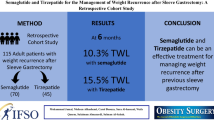Abstract
Background
The gastric bypass (GBP) is the most popular revisional technique after sleeve gastrectomy (SG). However, the results after revision are not always satisfactory in terms of additional weight loss and complications. The single anastomosis duodenoileal bypass (SADI) could be a valuable alternative.
Objective
This study is a retrospective matched-control study reviewing short-term results in terms of weight loss and comorbidities reduction of both SADI and GBP as a revisional procedure after primary sleeve gastrectomy. Complications and vitamin deficiencies will be evaluated as well.
Methods
Patients with a SADI procedure after a primary sleeve gastrectomy (SG) with a minimum follow-up of 1 year were included. Their results were retrospectively reviewed and matched with a cohort of GBP patient on age, BMI, and gender. Comparison was on comorbidities, weight loss, complications, and blood markers.
Results
A total of 64 patients were included, 32 SADI procedures and 32 matched gastric bypasses with no significant differences on baseline. No differences were found in terms of (additional) total weight loss. The operating time of the SADI was significantly longer (p = 0.007). No clinically relevant differences were found concerning comorbidities or blood markers. In the SADI group, more defecation problems were reported and fewer vitamin deficiencies were encountered.
Conclusion
Based on a small group and short-term results, the SADI could be regarded as a safe alternative to a GBP following SG with a similar amount of additional weight loss and fewer post-operative early complications. Longer follow-up and larger studies are needed to determine its full potential.

Similar content being viewed by others
References
Volksgezondheidenzorg.info. Overgewicht volwassenen 2017 [cited 2017 15th of February]. Available from: https://www.volksgezondheidenzorg.info/onderwerp/overgewicht/cijfers-context/huidige-situatie.
Major P, Matlok M, Pedziwiatr M, et al. Quality of life after bariatric surgery. Obes Surg. 2015;25(9):1703–10.
Karamanakos SN, Vagenas K, Kalfarentzos F, et al. Weight loss, appetite suppression, and changes in fasting and postprandial ghrelin and peptide-YY levels after roux-en-Y gastric bypass and sleeve gastrectomy: a prospective, double blind study. Ann Surg. 2008;247(3):401–7.
Dapri G, Cadiere GB, Himpens J. Superobese and super-superobese patients: 2-step laparoscopic duodenal switch. Surg Obes Relat Dis. 2011;7(6):703–8.
Sovik TT, Taha O, Aasheim ET, et al. Randomized clinical trial of laparoscopic gastric bypass versus laparoscopic duodenal switch for superobesity. Br J Surg. 2010;97(2):160–6.
Sanchez-Pernaute A, Herrera MA, Perez-Aguirre ME, et al. Single anastomosis duodeno-ileal bypass with sleeve gastrectomy (SADI-S). One to three-year follow-up. Obes Surg. 2010;20(12):1720–6.
Sanchez-Pernaute A, Rubio MA, Perez Aguirre E, et al. Single-anastomosis duodenoileal bypass with sleeve gastrectomy: metabolic improvement and weight loss in first 100 patients. Surg Obes Relat Dis. 2013;9(5):731–5.
Corcelles R, Boules M, Froylich D, et al. Total weight loss as the outcome measure of choice after roux-en-Y gastric bypass. Obes Surg. 2016;26(8):1794–8.
Sczepaniak JP, Owens ML, Shukla H, et al. Comparability of weight loss reporting after gastric bypass and sleeve gastrectomy using BOLD data 2008-2011. Obes Surg. 2015;25(5):788–95.
Shikora SA, Kim JJ, Tarnoff ME, et al. Laparoscopic roux-en-Y gastric bypass: results and learning curve of a high-volume academic program. Arch Surg. 2005;140(4):362–7.
Carmeli I, Golomb I, Sadot E, et al. Laparoscopic conversion of sleeve gastrectomy to a biliopancreatic diversion with duodenal switch or a roux-en-Y gastric bypass due to weight loss failure: our algorithm. Surg Obes Relat Dis. 2015;11(1):79–85.
Homan J, Betzel B, Aarts EO, van Laarhoven KJ, Janssen IM, Berends FJ. Secondary surgery after sleeve gastrectomy: Roux-en-Y gastric bypass or biliopancreatic diversion with duodenal switch. Surg Obes Relat Dis. 2015;11(4):771–7.
Sanchez-Pernaute A, Rubio MA, Conde M, et al. Single-anastomosis duodenoileal bypass as a second step after sleeve gastrectomy. Surg Obes Relat Dis. 2015;11(2):351–5.
Gibbons C, Caudwell P, Finlayson G, et al. Comparison of postprandial profiles of ghrelin, active GLP-1, and total PYY to meals varying in fat and carbohydrate and their association with hunger and the phases of satiety. J Clin Endocrinol Metab. 2013;98(5):E847–55.
Webb DL, Abrahamsson N, Sundbom M, et al. Bariatric surgery - time to replace with GLP-1? Scand J Gastroenterol. 2017;52(6–7):635–40.
Gebelli JP, Gordejuela AG, Ramos AC, et al. Sadi-S with Right Gastric Artery Ligation: Technical Systematization and Early Results. Arq Bras Cir Dig. 2016;29Suppl 1(Suppl 1):85–90.
Madan AK, Orth WS, Tichansky DS, et al. Vitamin and trace mineral levels after laparoscopic gastric bypass. Obes Surg. 2006;16(5):603–6.
Kjellmo CA, Karlsson H, Nestvold TK, Ljunggren S, Cederbrant K, Marcusson-Stahl M, et al. Bariatric surgery improves lipoprotein profile in morbidly obese patients by reducing LDL cholesterol, apoB, and SAA/PON1 ratio, increasing HDL cholesterol, but has no effect on cholesterol efflux capacity. J Clin Lipidol 2017.
Greenstein AJ, O'Rourke RW. Abdominal pain after gastric bypass: suspects and solutions. Am J Surg. 2011;201(6):819–27.
Johnson JM, Maher JW, DeMaria EJ, et al. The long-term effects of gastric bypass on vitamin D metabolism. Ann Surg. 2006;243(5):701–4. discussion 4-5
Author information
Authors and Affiliations
Corresponding author
Ethics declarations
All procedures performed in studies involving human participants were in accordance with the ethical standards of the institutional and/or national research committee and with the 1964 Helsinki declaration and its later amendments or comparable ethical standards.
Conflict of Interest
The authors declare that they have no conflict of interests.
Informed Consent
Informed consent was obtained from all individual participants included in the study.
Rights and permissions
About this article
Cite this article
Ceha, C.M.M., van Wezenbeek, M.R., Versteegden, D.P.A. et al. Matched Short-Term Results of SADI Versus GBP After Sleeve Gastrectomy. OBES SURG 28, 3809–3814 (2018). https://doi.org/10.1007/s11695-018-3415-5
Published:
Issue Date:
DOI: https://doi.org/10.1007/s11695-018-3415-5




